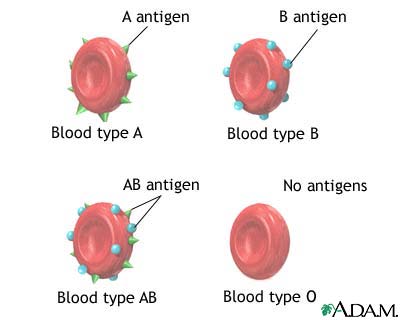Blood type - A, B, 0, AB, ABO

Blood Type - the pattern of specialized proteins, called agglutinogens or antigens, present on the surface of the red BLOOD cells (erythrocytes). The presence of antigens on the erythrocytes causes the IMMUNE SYSTEM to create oppositional antibodies, which will attack cells bearing the opposing antigens. Antigens and corresponding antibodies begin to develop shortly following birth. The discovery of blood types in the early 1900s made successful BLOOD TRANSFUSION possible, earning researcher Karl Landsteiner (1868-1943) the 1930 Nobel Prize in medicine or physiology. Landsteiner was also among the group of scientists who discovered the rhesus (Rh) factor, another red blood cell antigen, in the 1940s.
ABO Blood Types
There are four blood types: A, B, AB, and O. Each designates the presence or absence of specific blood antigens and antibodies. Each type causes an immune reaction to blood from its opposite type. The exception is type O blood, which has no antigens on its cell surfaces. Type AB blood has antigens A and B on its cell surfaces. Doctors sometimes refer to people who have type O blood as universal donors because people of any blood type can receive emergency transfusions of type O blood (preferably as packed red blood cells containing little of the antibody-carrying PLASMA), and people who have type AB blood as universal recipients because they can receive blood of any type in emergency transfusions.
| ABO BLOOD TYPES | ||
|---|---|---|
| Blood | Type Antigens on Erythrocytes | Antibodies in Plasma |
| A | A | anti-B |
| B | B | anti-A |
| AB | A and B | none |
| O | none | anti-A and anti-B |
Rh Blood Types
Blood typing further incorporates tests for the presence or absence of a group of antigens known collectively as the rhesus (Rh) factor. The name derives from the rhesus monkey, the animal in which researchers first isolated the antigens. When the antigens are present on the erythrocytes the designation is Rh positive (Rh+); when the antigens are not present the designation is Rh negative (Rh-). Less than 15 percent of the American population has Rh- blood. Though collectively there are more than 40 identified antigens in the Rh blood type system, nearly all antibody response arises from Rh-D antigens. Most blood type classifications represent the ABO type and Rh status together, as in AB+ or O-.
An immune response occurs when Rh+ and Rh- blood mingle, irrespective of the ABO blood type. The health risk is to the individual whose blood is Rh-. Rh incompatibility is a serious threat to the life of an unborn child and can manifest when a mother who is Rh- conceives a child who is Rh+. The first commingling of Rh-incompatible blood typically does not result in adverse effects because the mother’s Rh- blood does not yet contain antibodies against the fetus’s Rh+ blood, but the first exposure to Rh+ blood activates ANTIBODY production in the mother. The first child in an Rhincompatible pregnancy typically is born without complications; however, subsequent pregnancies result in the mother’s body producing massive Rh+ antibodies that cross the PLACENTA and destroy the fetus’s Rh+ erythrocytes. This condition, called hemolytic disease of the newborn (HDN) or erythroblastosis fetalis, often kills the unborn child.
The standard of PRENATAL CARE in the United States includes blood tests to determine maternal Rh status, with an injection of Rh IMMUNOGLOBULIN to prevent antibody formation in women who have Rh- blood. Rh incompatibility also can cause transfusion reaction when a person who has Rh- blood receives Rh+ blood. Such transfusion reactions can cause serious ANEMIA and cell agglutination (clumping) that can result in death.
Distribution of Blood Types
The most common blood type among Americans is O+ (38 percent); the least common is AB- (1 percent). Genes determine blood type (ABO as well as Rh). Before the advent of DNA sequencing and HUMAN LEUKOCYTE ANTIGENS (HLAS) typing, blood type was the basis of paternity testing. There are enough variations in blood type INHERITANCE PATTERNS, however, to make blood type less than 100 percent reliable for determining parentage, and blood type is no longer legal proof of parentage in the United States.
| PERCENTAGES OF BLOOD TYPES AMONG AMERICANS | |
|---|---|
| type O+ | 38 percent |
| type A+ | 34 percent |
| type B+ | 9 percent |
| type O- | 7 percent |
| type A- | 6 percent |
| type AB+ | 3 percent |
| type B- | 2 percent |
| type AB- | 1 percent |
| Source: American Association of Blood Banks, 2005 | |
See also BLOOD AUTODONATION; BLOOD DONATION.